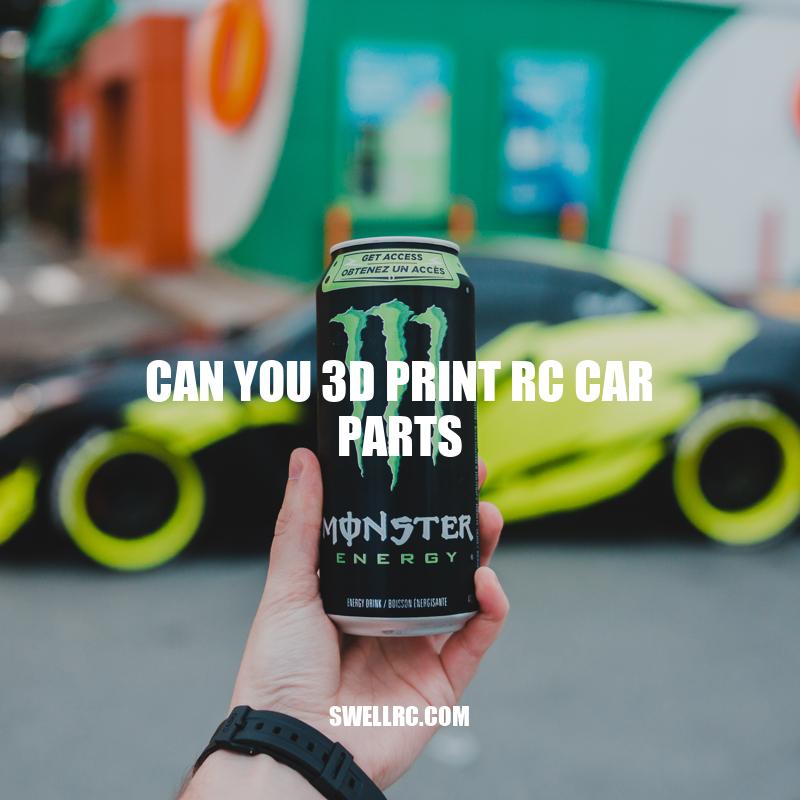3D Printing RC Car Parts: Benefits, Challenges and Tips
Remote-controlled (RC) cars have become increasingly popular, with hobbyists and enthusiasts around the world investing in these miniature vehicles. However, the wear and tear that comes with regular use can lead to the need for replacement parts. Luckily, the emergence of 3D printing technology has made it possible for individuals to create new and customized parts for their RC cars, without the need to rely on traditional manufacturers for replacements. But can 3D printing really be used to create functional and practical RC car parts? In this article, we’ll explore the benefits and limitations of using 3D printing technology for RC car parts, as well as provide tips for successfully implementing this technology for your RC car projects. Whether you’re an experienced hobbyist or just starting out, this article will provide you with valuable information about 3D printing technology and its potential role in the world of RC cars.
Understanding 3D Printing
To understand the benefits and challenges of 3D printing for RC car parts, it’s important to have a basic understanding of how the printing process works. Some key points to keep in mind include:
- 3D printing involves the creation of a physical object from a digital model using specialized equipment.
- The most commonly used materials in 3D printing include ABS and PLA plastics, although other materials such as metals and wood can also be used in some cases.
- There are various methods of 3D printing, including fused deposition modeling (FDM), stereolithography (SLA), and selective laser sintering (SLS), among others.
- 3D printing requires a digital design file of the part you wish to print, which can be created using 3D modeling software or downloaded from online libraries such as Thingiverse or GrabCAD.
By understanding these basic tenets of 3D printing, one can gain a better understanding of how it can be used in the context of RC car parts. Keep reading to learn more about the benefits and challenges of 3D printing for RC cars.
Benefits of 3D Printing for RC Cars
There are several compelling reasons why 3D printing is an attractive option for RC car enthusiasts looking to create replacement or custom parts for their cars. Some of the main benefits of 3D printing for RC cars include:
| Benefit | Description |
|---|---|
| Cost-Effective | 3D printing allows for the creation of parts at a significantly lower cost than traditional manufacturing methods, making it an economical choice for many hobbyists. |
| Customization | 3D printing allows for the creation of highly customized parts, with endless possibilities for design and personalization. |
| Speed and Convenience | 3D printing allows hobbyists to quickly and easily create replacement parts on-demand, without having to wait for parts to be shipped from manufacturers. |
In addition to these benefits, 3D printing also offers the potential for more sustainable and eco-friendly manufacturing practices, as it eliminates the need for excess inventory and reduces overall waste. The ability to rapidly prototype and iterate on designs is also a key advantage of 3D printing, allowing hobbyists to experiment with different designs and configurations in a more efficient and cost-effective manner.
Can you make an RC car with a 3D printer?
Yes, you can make an RC car with a 3D printer. 3D printing technology has advanced to a point where it’s possible to create high-quality RC car parts and bodies with a 3D printer. However, you’ll need to have the design knowledge and experience necessary to create a functioning RC car. There are a wide variety of 3D printing designs available online that can be used to create RC car parts, as well as several ready-made RC car kits that incorporate 3D printed components. Websites like Thingiverse, MyMiniFactory, and GrabCAD offer a range of designs and kits that can help you get started with making your own RC car using a 3D printer.
Potential Challenges of 3D Printing for RC Cars
While 3D printing offers several benefits for creating replacement parts for RC cars, there are also some potential challenges that hobbyists should be aware of. These include:
- Technical Expertise: 3D printing requires a certain level of technical knowledge and experience, which can be intimidating for some beginners.
- Quality Limitations: Depending on the quality of the 3D printer and the type of materials used, some parts may not be as strong, durable, or accurate as those created through traditional manufacturing methods.
- Design Complexity: More complex designs require more advanced software skills and may take longer to create.
However, despite these potential challenges, many hobbyists have successfully used 3D printing to create a wide range of high-quality, functional parts for their RC cars. There are also numerous resources available online, such as Thingiverse and MyMiniFactory, that offer free designs and printing files for a variety of RC car parts. By taking the time to learn the ins and outs of 3D printing technology and utilizing these resources, hobbyists can overcome the challenges and unlock the full potential of this exciting new manufacturing method.
Can I 3D print RC car parts?
Yes, you can 3D print RC car parts. Here are some things to keep in mind:
- The design of the part needs to be created in a 3D modeling software.
- You will need access to a 3D printer or a 3D printing service.
- The material used for 3D printing needs to be strong enough to handle the stress and strain of the RC car.
- There are many websites and online stores that offer 3D printed parts for RC cars, such as Shapeways and Thingiverse.
Tips for 3D Printing RC Car Parts
To ensure success with 3D printing RC car parts, there are several tips and best practices to keep in mind. These include:
- Using High-Quality Filaments: Using high-quality filaments is essential for creating strong and durable parts.
- Properly Calibrating the 3D Printer: Ensuring that the 3D printer is properly calibrated is crucial for achieving high-quality and accurate prints.
- Creating Detailed Designs: Designing parts with precise measurements using CAD software is key to creating parts that fit correctly and work properly.
- Adding Support Structures: Adding support structures can help prevent deformities or warping during the printing process.
- Finishing the Printed Parts: Finishing the printed parts or post-processing may be necessary to make them functional for use.
- Utilizing Online Resources: There are numerous online resources, such as Cults3D and Pinshape, that offer free and paid designs for 3D printed RC car parts.
By following these tips and doing proper research beforehand, hobbyists can create high-quality and functional RC car parts using 3D printing technology.
Can I 3D Print RC Car Parts?
Yes, you can 3D print RC car parts. Many hobbyists have successfully designed and printed their own parts to upgrade or repair their RC cars. However, it’s important to note that not all 3D printers and materials are suitable for creating RC car parts that can withstand the wear and tear of regular use.
Here are a few tips to keep in mind:
- Choose a durable material such as ABS or nylon for your prints.
- Print multiple parts at once to optimize your printing time and conserve material.
- Use a high-quality 3D printer with a high resolution to produce accurate and detailed prints.
- Consider using online 3D printing services such as Shapeways or Sculpteo if you don’t have access to a 3D printer.
Overall, 3D printing can be a great way to customize your RC car and create parts that may not be available commercially. Keep in mind that it may take some trial and error to perfect your 3D printing skills and find the right materials and settings for your specific application.
Examples of 3D Printed RC Car Parts
There are many RC car parts that can be 3D printed, from simple to complex designs that can help improve the overall performance of the car. Here are a few examples:
Wheels
- Customized wheel designs can improve traction and speed on different surfaces.
- Tires can be designed with different tread patterns for added grip and control.
Gears and Suspension Components
- Gears and suspension components can provide smoother operation and better control over uneven terrain.
- Crown gears, pinion gears, and differentials can all be 3D printed.
Car Bodies and Accessories
- Custom car bodies can be created to give the RC car a unique look and design.
- Accessories such as roll cages, lights, and spoilers can also be 3D printed.
There are many websites where users can download 3D designs for RC car parts or create their own, including Thingiverse and MyMiniFactory. Some sites, such as Shapeways, even offer professional 3D printing services for those who are unable to print their own parts. With the help of 3D printing, anyone can create custom and functional parts for their RC cars, which can help enhance their performance and overall experience.
Can you make a custom RC car?
Yes, it is possible to make a custom RC car. Here are some steps to get started:
- Choose a base RC car model to modify
- Decide on the modifications you want to make
- Gather necessary tools and parts
- Begin modifying the car, making sure to follow safety guidelines
- Test the car and make any necessary adjustments
There are also many online resources and forums dedicated to RC car customization, such as RC Car Action and RCGroups. You may also consider purchasing customization kits from websites like Tower Hobbies or Horizon Hobby.
Conclusion
In conclusion, 3D printing has revolutionized the way that people approach creating replacement or customized parts for their RC cars. This technology has made it possible to quickly create replacement parts at home, and has allowed for personalized modifications to be made to cars to enhance their performance and aesthetics. However, there are also some potential challenges associated with 3D printing, such as the need for specialized knowledge and equipment. Overall, though, 3D printing offers a cost-effective and customizable way to repair and optimize RC cars.
Using 3D printing to create custom RC car parts can be a fun and rewarding experience for those in the RC car community, and with the availability of 3D designs and printing services, it has never been easier to get started. By following some basic guidelines, such as ensuring proper calibration and post-processing of 3D printed parts, anyone can create functional and effective parts for their RC cars. With the continued growth and advancements of 3D printing technology, it is exciting to think about what new opportunities and possibilities the future may hold for the RC car community and beyond.



